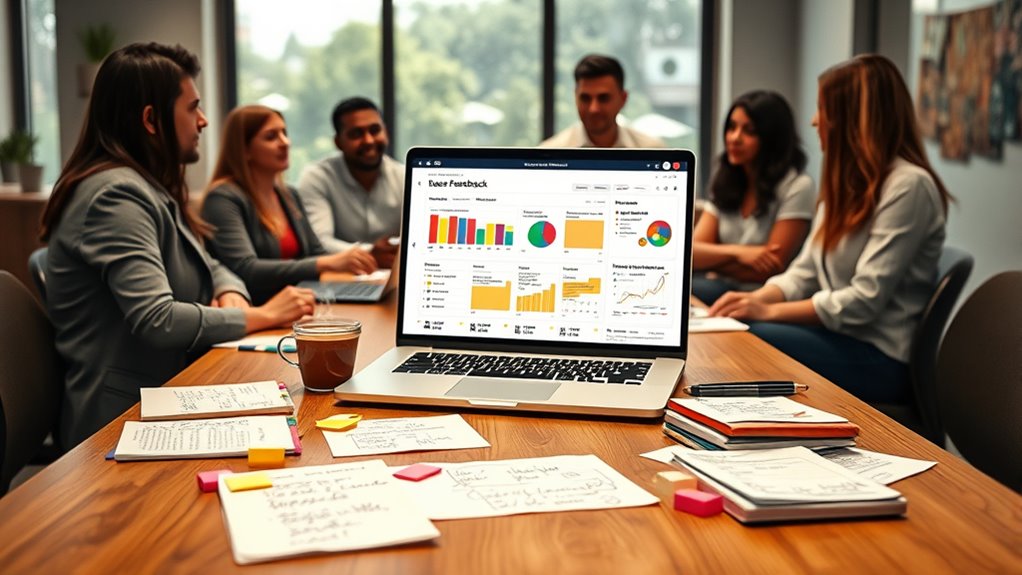To build continuous discovery habits with weekly user touchpoints, you should regularly gather feedback, stay aligned with evolving needs, and adapt your approach based on insights. Use targeted interviews, surveys, and data analysis to identify pain points early and improve quickly. Consistency is key, but personalization and responsiveness help deepen user relationships. Keep refining your methods, and you’ll discover more ways to create valuable, lasting connections—there’s much more to explore ahead.
Key Takeaways
- Establish a regular, flexible schedule for user interactions to maintain consistent engagement and gather ongoing feedback.
- Use persona insights and targeted questions to tailor conversations and uncover user pain points effectively.
- Combine qualitative and quantitative data from weekly touchpoints to inform product improvements and strategic decisions.
- Analyze engagement metrics and user feedback to identify dips and adapt strategies for sustained interest.
- Foster trust and stronger connections through personalized, relevant interactions aligned with user needs and preferences.
The Importance of Regular User Feedback

Regular user feedback is essential because it keeps you aligned with your customers’ evolving needs and preferences. By actively listening, you demonstrate customer empathy, showing you value their experiences and insights. Feedback loops create a continuous cycle where you gather input, analyze it, and implement improvements. This process helps you identify pain points early and adapt quickly, preventing larger issues down the line. When you prioritize regular feedback, you build trust and loyalty, making users feel heard and valued. It also allows you to stay ahead of market trends and refine your offerings accordingly. Color accuracy is a crucial aspect of home cinema projectors that directly impacts image quality, and ongoing user feedback can reveal how well your products meet viewers’ expectations in this area. Consistent engagement ensures your product remains relevant and effective, ultimately driving better customer satisfaction and business growth.
Setting Up Effective Weekly Touchpoints

To keep your team aligned and responsive, establishing effective weekly touchpoints is essential. Start by reviewing customer segmentation to identify which groups need the most attention that week. Use these insights to prioritize conversations and ensure you’re addressing their specific needs. Incorporate competitive analysis into your discussions to stay aware of market shifts and competitors’ moves. Keep your touchpoints focused by setting clear objectives, such as validating assumptions or gathering feedback. Maintain a consistent schedule, but remain flexible to adapt based on recent findings or emerging opportunities. Encourage open dialogue and active participation from all team members, fostering a culture of continuous learning. Regularly review and update your understanding of evolving market trends to stay ahead of customer needs and preferences. This deliberate approach guarantees your discovery efforts stay targeted, timely, and aligned with your overall strategy.
Tools and Techniques for Continuous Discovery

To keep your discovery efforts effective, you need the right tools and techniques for gathering insights. User interview methods and data collection strategies help you understand your customers’ needs and behaviors consistently. Mastering these approaches guarantees you stay aligned with your users and make informed decisions. Incorporating asset division strategies into your understanding of client needs can also enhance your ability to identify key pain points and opportunities.
User Interview Methods
User interview methods are essential tools in continuous discovery because they help you gather firsthand insights directly from your users. To make these interviews effective, start with persona mapping to understand who you’re speaking with and tailor your questions accordingly. Developing a solid interview script ensures your conversations stay focused and cover key topics without leading or biasing responses. Use open-ended questions to encourage detailed feedback and explore users’ motivations, pain points, and behaviors. Keep the tone friendly and conversational, making users comfortable sharing honest insights. Record and organize your findings systematically to identify patterns over time. By refining your interview techniques, you’ll gain a deeper understanding of your users, which drives smarter product decisions and continuous improvement.
Data Collection Strategies
Effective data collection strategies build on your user interview efforts by leveraging a variety of tools and techniques to gather exhaustive insights. You can use digital surveys, analytics platforms, and feedback forms to complement interviews and capture broader user behaviors. Persona segmentation helps you organize data by user types, enabling targeted analysis and personalized discovery. To protect user privacy, employ data anonymization techniques, ensuring sensitive information remains confidential while still providing valuable insights. Combining quantitative tools with qualitative methods gives you a comprehensive overview of user needs, preferences, and pain points. This multi-faceted approach allows you to identify patterns more effectively and refine your product strategies continuously. Additionally, understanding Pimple Patch technology can inform your analysis of product-specific user feedback, leading to more tailored improvements. Ultimately, diverse data collection strengthens your understanding, supporting more informed, user-centered decisions.
Integrating User Insights Into Product Development

Integrating user insights into product development requires a deliberate and systematic approach to guarantee that customer needs truly shape the final product. Begin by using persona mapping to clearly define your target users, their goals, and pain points. This helps you stay focused on real customer needs during development. Conduct competitive analysis to identify gaps and opportunities that resonate with user insights, ensuring your product offers unique value. Regularly share these insights with your team to inform design decisions, prioritization, and feature development. By embedding user feedback into your processes, you create a culture of continuous learning and responsiveness. This alignment ensures your product evolves in a way that genuinely meets user expectations, increasing customer satisfaction and long-term success. Additionally, understanding juice extraction techniques can inform product features related to nutrition and health, fostering innovation that aligns with user wellness interests.
Overcoming Challenges in Consistent Engagement

Keeping your team engaged consistently can be tough, but establishing a regular schedule for interactions helps. You need to find ways to sustain momentum so conversations don’t fade over time. When you prioritize consistent engagement, gathering valuable insights becomes much easier. Incorporating essential oils for ongoing wellness into your routine can also support a positive environment that encourages continuous dialogue.
Scheduling Regular Interactions
Scheduling regular interactions can be challenging, especially when competing priorities or unpredictable schedules get in the way. To overcome this, start with clear persona mapping to understand who your users are and their preferred times. This insight helps you choose ideal moments for engagement, increasing the chance they’ll participate consistently. Stakeholder alignment is also essential; ensure everyone involved understands the importance of these touchpoints and commits to maintaining them. Use shared calendars or scheduling tools to coordinate availability and set recurring reminders. By aligning your team and respecting user preferences, you create a sustainable rhythm for interactions. This approach reduces friction and helps build a routine that keeps discovery habits strong, even when busy schedules threaten to disrupt your efforts. Incorporating scheduled touchpoints in aquatic exercise programs can further enhance user engagement by reminding participants of their routines and encouraging ongoing participation.
Maintaining Engagement Momentum
Even with a steady rhythm of interactions in place, maintaining that engagement over time can be a real challenge. To sustain momentum, you need effective retention strategies that keep users invested and interested. Regularly reviewing engagement metrics helps identify when engagement dips and highlights areas for improvement. Focus on personalized touches and relevant content to deepen user connection. Setting clear goals for each touchpoint ensures your efforts remain intentional and measurable. Remember, consistency alone isn’t enough; you must adapt your approach based on data insights. Incorporating relationship awareness into your engagement efforts can help you better understand user needs and foster stronger connections. By continuously refining your retention strategies and tracking engagement metrics, you can overcome the natural decline in user interest and sustain a meaningful discovery habit that drives long-term value.
Measuring Success and Refining Your Approach

To effectively measure success and refine your approach, you need clear, actionable metrics that reflect your discovery process and product impact. Focus on customer satisfaction; regular feedback helps identify what’s working and what needs adjustment. Track how users engage with features to inform feature prioritization, ensuring you’re investing in the most valuable improvements. Use qualitative insights from user interviews and surveys alongside quantitative data like retention rates and conversion metrics. This combination reveals whether your efforts are resonating and guiding your next steps. Continuously analyzing these indicators allows you to adapt your approach, validate assumptions, and refine your discovery habits. By staying aligned with user needs and business goals, you create a cycle of ongoing improvement that drives product success. Additionally, understanding symptoms of breast cancer can help tailor your discovery efforts to address user concerns more comprehensively.
Frequently Asked Questions
How Can Team Members Stay Motivated for Ongoing User Engagement?
To keep team members motivated for ongoing user engagement, focus on highlighting the impact their efforts have on users. Celebrate small wins and share positive user feedback regularly. Encourage collaborative discussions about user insights, making the process meaningful. When team members see how their work improves user experiences, their motivation and team engagement grow, creating a cycle of continuous enthusiasm and commitment to understanding users better.
What Are Common Pitfalls in Establishing Weekly Discovery Routines?
When establishing weekly discovery routines, you might face pitfalls like overcoming complacency, which can cause your team to lose focus or skip sessions. Managing feedback overload is also critical; too much input can overwhelm your team and dilute insights. To stay effective, set clear goals, prioritize feedback, and keep routines engaging. This way, you maintain momentum and ensure ongoing user engagement without burnout or stagnation.
How Do You Prioritize User Feedback Amidst Other Product Tasks?
Think of user feedback as a garden needing careful tending. To prioritize feedback, you must sort through user input management, focusing on what’s most impactful for your product goals. Use feedback prioritization techniques like scoring or grouping to identify urgent issues. By aligning user input with your team’s capacity, you guarantee that critical insights shape your roadmap, rather than getting lost in a sea of less essential suggestions.
Can Small Teams Effectively Implement Continuous Discovery Practices?
Small teams can effectively implement continuous discovery practices by focusing on team collaboration and smart resource allocation. By sharing responsibilities and communicating regularly, you guarantee everyone stays aligned on user insights. Prioritize key user feedback and dedicate specific time for discovery activities, making the process manageable within your limited resources. This approach allows you to stay responsive to user needs without overwhelming your team or sacrificing other product tasks.
How Do You Handle Negative or Unhelpful User Feedback?
Imagine catching a stray arrow—negative feedback can sting, but it’s part of the process. You handle unhelpful comments by building emotional resilience, staying open-minded without taking it personally. Use feedback filtering to separate constructive insights from noise, and focus on what’s actionable. This way, you grow stronger, learn more effectively, and turn criticism into a tool for continuous improvement, rather than a setback.
Conclusion
By making weekly user touchpoints a habit, you tap into a steady flow of insights that can transform your product. It’s amazing how small, consistent efforts often lead to big breakthroughs—like catching a trend just in time or solving a problem before it grows. When you stay connected, you’re not just building a better product; you’re creating a genuine relationship with your users. Sometimes, it’s those regular moments that unexpectedly lead to your next big success.









